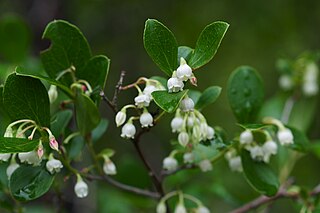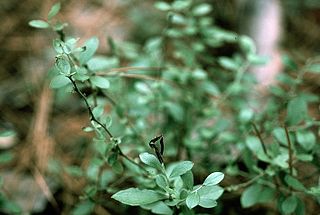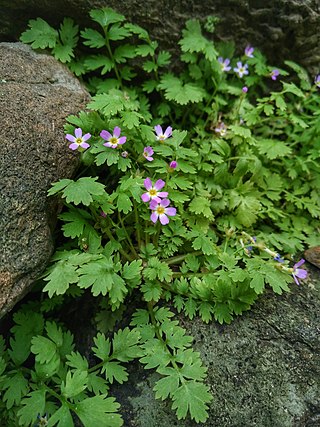
Vaccinium macrocarpon, also called large cranberry, American cranberry and bearberry, is a North American species of cranberry in the subgenus Oxycoccus.

Coreopsis lanceolata, commonly known as lanceleaf coreopsis, lanceleaf tickseed, lance-leaved coreopsis, or sand coreopsis, is a North American species of tickseed in the family Asteraceae.

Vaccinium corymbosum, the northern highbush blueberry, is a North American species of blueberry which has become a food crop of significant economic importance. It is native to eastern Canada and the eastern and southern United States, from Ontario east to Nova Scotia and south as far as Florida and eastern Texas. It is also naturalized in other places: Europe, Japan, New Zealand, the Pacific Northwest of North America, etc. Other common names include blue huckleberry, tall huckleberry, swamp huckleberry, high blueberry, and swamp blueberry.

Vaccinium arboreum is a species of Vaccinium native to the southeastern and south-central United States, from southern Virginia west to southeastern Nebraska, south to Florida and eastern Texas, and north to Illinois.

Vaccinium uliginosum is a Eurasian and North American flowering plant in the heath family Ericaceae.

Commelina communis, commonly known as the Asiatic dayflower, is an herbaceous annual plant in the dayflower family. It gets its name because the blooms last for only one day. It is native throughout much of East Asia and northern parts of Southeast Asia. In China, the plant is known as yazhicao, roughly translating to "duckfoot herb", while in Japan it is known as tsuyukusa, meaning "dew herb". It has also been introduced to parts of central and southeastern Europe and much of eastern North America, where it has spread to become a noxious weed. It is common in disturbed sites and in moist soil. The flowers emerge from summer through fall and are distinctive with two relatively large blue petals and one very small white petal.

Heritiera littoralis, commonly known as the looking-glass mangrove or tulip mangrove, is a mangrove tree in the family Malvaceae native to coastal areas of eastern Africa, Asia, Melanesia and northern Australia. The common name refers to the silvery appearance of the underside of the leaves, resembling a mirror to some degree. The strong timber has uses in marine applications and elsewhere.

Murraya paniculata, commonly known as orange jasmine, orange jessamine, china box or mock orange, is a species of shrub or small tree in the family Rutaceae and is native to South Asia, Southeast Asia and Australia. It has smooth bark, pinnate leaves with up to seven egg-shaped to elliptical leaflets, fragrant white or cream-coloured flowers and oval, orange-red berries containing hairy seeds.
Ampelocissus xizangensis is a deciduous vine in the family Vitaceae, native to shrublands in the high valleys of the Tibet Autonomous Region and Nepal, at elevations about 2000 m high.

Ardisia solanacea, called shoebutton ardisia in English, is a species of the genus Ardisia in family Primulaceae.

Madeira blueberry or Uva-de-serra is very common at elevations between 800 and 1,700 metres. It grows mainly in crevices and exposed slopes and mountain plains. Fruits are used in preserves. It is endemic to the islands of Madeira and Porto Santo, Portugal.

Vaccinium hirsutum is a species of flowering plant in the heath family known by the common name hairy blueberry. This species is endemic to a small area in the southern Appalachian mountains, where it is only known from a few counties in eastern Tennessee, northern Georgia, and the Carolinas.

Vaccinium tenellum, the small black blueberry is a plant species native to the southeastern United States from southeastern Mississippi to northern Florida to southern Virginia. It grows in forests and in shrubby areas at elevations up to 200 m.

Entada phaseoloides, commonly known in English as the matchbox bean or St. Thomas' bean, is a large twining vine or liana in the pea and bean family Fabaceae, native to a broad area of Asia-Pacific, from China to northern Australia and the southwestern Pacific.

Acacia pubifolia commonly known as velvet wattle, is a flowering plant in the family Fabaceae and is endemic to northern New South Wales. It is an upright or spreading tree with bright yellow flowers.

Trollius yunnanensis, the Yunnan globeflower, is a species of globeflower, native to southern China; Gansu, Sichuan and Yunnan provinces, and to northern Myanmar. A perennial, it prefers to grow at elevations from 1,900 m up to 3,900 m on grassy slopes and wet meadows. It has gained the Royal Horticultural Society's Award of Garden Merit.

Symphyotrichum racemosum is a species of flowering plant native to parts of the United States and introduced in Canada. It is known as smooth white oldfield aster and small white aster. It is a perennial, herbaceous plant in the family Asteraceae. It is a late-summer and fall blooming flower.
Hopea vacciniifolia is a tree in the family Dipterocarpaceae, native to Borneo. The specific epithet vacciniifolia refers to the leaves' similarity to those of the genus Vaccinium.
Zanthoxylum laetum is a species of woody plant from the Rutaceae family.

Primula cicutariifolia, is a species of flowering plant within the genus Primula and family Primulaceae.

















